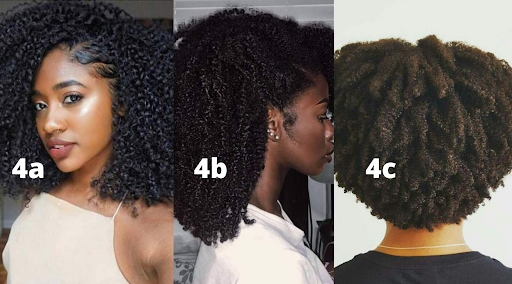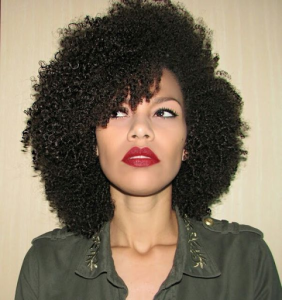The Differences Between 4A, 4B, & 4C Hair

If you are familiar with the fashion and hair industry, you might be aware that hair is categorized into 4 types, and they are further classified under 3 additional sub-categories. While types 1-3 are easily recognizable, type 4 hair can get a bit tricky. You could have a combination of both tight and loose curls and coils or have tight coils at the crown and looser ones on the side. In this blog, we will discuss 4A, 4B, & 4C hair individually and look into the differences between the 3 subcategories so you can have an understanding of type 4 hair.
A Glimpse Into Type 4 Hair

The texture type 4 hair, is known to have a variety of textures based on the 3 subcategories. In type 4 hair, the strands form tight strands of zig-zag curls from the scalp and are extremely prone to shrinkage due to lack of moisture. Each sub-category of type 4 hair is distinct, with its own set of curls, kinks, and coils.
Type 4A Hair

Curls in type 4a hair are medium in size and lightly coiled. The 4a curls are lively, s-shaped, and about the size of a crochet needle. The curls in 4a hair are not quite as entwined as the 4b or 4c hair curls. 4a strands curl away from surrounding strands, enhancing the texture and providing a well-defined look.
4A Hair Care Tips:
This hair type can suffer from shrinkage, so 4a hair benefits from moisturizing treatments and curl-defining products. Here are 5 tips for maintaining your 4a mane:
- 4a hair is vulnerable to dryness and requires hydration. Apply shea butter and essential oils to reduce hair damage and breakage during styling.
- Apply natural oils like black castor oil, almond, coconut, and avocado oil throughout the length of your 4a hair. These oils help reduce hair loss and strengthen hair.
- Don’t wash your 4a hair more than three times a week, and always follow up the wash with conditioning.
- Deep condition regularly to add moisture to your strands.
- For naturally dry hair, it’s best to use sulfate-free shampoos and conditioners.
4A Styles:
With the 4a sub-category, there are endless hairstyle options regardless of the hair’s length. Due to the well-defined curls, wash-and-go hairstyles are perfect for 4a hair.
Type 4B Hair

The curls in 4b hair are denser and tighter than those in 4a and have a zig-zag coily pattern. Curls in the 4b sub-category are narrower and less defined than those in the 4a. They come in various textures, from fine and thin to wiry and coarse. 4b hair is typically bouncy, resembling cotton candy. Compared to 4a hair, 4b experiences tremendous shrinkage (up to 70% of its actual length) and is more prone to dryness and breakage.
4B Hair Care Tips:
Compared to 4a, 4b is more prone to shrinkage, so strengthening and moisturizing treatments are essential for this hair type. If you want to define the curls, use a curl-defining cream after washing your 4b hair. Use the following 5 hair care tips for your 4b hair:
- Proper moisturization and moisture retention are important for 4b hair, so it’s important to hydrate it with water or a leave-in conditioner.
- Only wash your 4b hair when necessary. Otherwise, you can use paraben-free dry shampoo or co-wash your 4b hair.
- Always pre-poo 4b hair with natural and essential oils, and always follow it by using a deep-conditioner to retain moisture.
- Use the LOC or LCO method after every wash. Style your 4b hair type using a moisturizing leave-in conditioner or gel.
- It is advised not to blow-dry 4b hair without a diffuser, and always use your fingers or a wide-tooth comb to detangle.
4B Styles
Wash-and-go hairstyles are also achievable with 4b natural virgin hair but require a bit more work to avoid shrinkage and define curls. Are you confused about the different types of hair? 4A, 4B, and 4C hair can all be different in texture, density, and curl pattern. But don’t worry – we’re here to help! This quick guide will tell you all about the differences between these types of hair, and how to take care of each one. Read on to learn more!
Type 4C hair

The queen of voluminous, beautiful, and dramatic afros is 4c hair. From afar, 4c hair appears to be a thick Afro, but at a closer inspection, you will notice very tight coils throughout the hair. Curls and coils are not the same. Curls are spiral strands that are simple to see and distinguish, whereas coils are tiny strands of hair that resemble springs and are difficult to discern from a distance. 4c hair is especially prone to shrinkage (up to 85%) and breakage due to the tight curls. 4c hair is so tightly curled around itself that it can quickly snap or break if not handled appropriately.
Follow these 5 care tips to maintain your 4c hair :
- 4c hair is normally dry and has a hard time retaining moisture; therefore, moisturizers like water and leave-in conditioners and sealants are essential for elasticity. Always moisturize your kinky hair before styling it to minimize breakage.
- Never over-shampoo your natural 4c hair and only wash them twice a week. Always choose sulfate-free shampoo to retain moisture.
- Deep-condition your 4c hair every week to keep your heavily textured hair bouncy, healthy, and shiny.
- Detangle your 4c hair when it’s damp with a wide-tooth comb. You can also detangle it after applying a conditioner. Always shampoo, condition, and detangle in sections.
- Be mindful of the products you use and keep styling to a minimum to prevent breakage.
4C Styles
Since 4c hair is extremely fragile, protective hairstyles with low manipulations are the best option. Twist-outs, Bantu knots, and Two-strand twists are some of the most popular styles for 4c hair. Do you know what the difference is between 4A, 4B, and 4C hair? Or which category your hair falls under? This guide will help you understand the differences between each type of hair, how to style it, and the best products to use. Keep reading to learn more!
Notable Differences Between 4A, B, & C Hair
Here are a few notable differences between 4A, B, & C hair.
| 4A Hair Type | 4B Hair Type | 4C Hair Type |
| 4A has soft and consistent curly textures that are well-defined. | 4B natural hair has wiry and tight coily textures and is less defined than 4A. The strands range from coarse, fine, and wiry to thin. | 4C hair has a tight, kinky texture that’s visible only at a closer glance. Among the 3 sub-categories, 4c hair is the most prone to shrinkage and is the most delicate. The hair stands range from coarse and wiry to soft and superfine. |
| Less shrinkage compared to the other 2. | Will shrink up to 70% | Shrinkage over 70% and up to 85% |
Conclusion
These are the differences between 4A, 4B, & 4C hair. Use the hair care tips and styling information mentioned above to style your hair. Indique Virgin Hair Extensions is the place for you if you are looking for sulfate-free shampoo and conditioner and nourishing hair care products for your 4A, B, & C hair. They have a line of in-house products and even carry a selection of Design Essentials products for type 3 and 4 natural hair.



